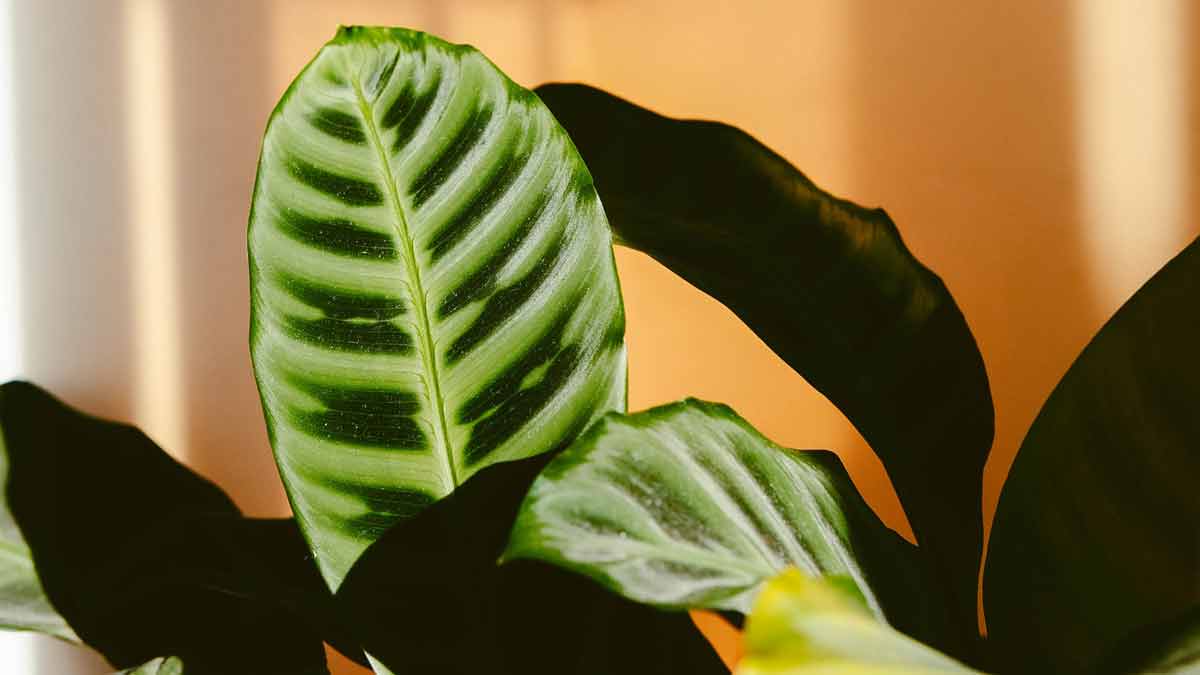There’s nothing worse than watching your beautiful calathea slowly wilt away. A calathea, also known as a prayer plant, is a lovely and colorful addition to any home. But when it starts to show signs of root rot, it can be a heartbreaking sight.
However, all is not lost. With some care and understanding, you can save your beloved calathea from root rot and return it to its former glory.
Here’s what you should know about your plant’s condition and how to treat it.
What is Root Rot?
Root rot is a devastating disease that attacks plant roots, causing them to rot and wither away.
It occurs when the roots of a plant are exposed to excess moisture, leading to overly wet soil and high levels of bacteria in the area.
Overwatering, poor drainage, underwatering, root damage, compact soil, and fungal infections are all culprits of this dangerous condition.
Two of the most common soil fungi that cause root rot are Fusarium and Pythium. Fusarium is a fungus that thrives on dead or dying plant tissues. At the same time, Pythium is a bacterial organism that often spreads through fungus gnats.
What Causes Root Rot in Calathea?
Calathea plants can succumb to root rot for a variety of reasons. These are the most frequent ones:
1. Overwatering
Overwatering is the most frequent cause of root rot in calathea plants. It occurs when too much water is allowed to remain in the soil, leading to soggy soil that can create an environment conducive to fungal growth.
Excessive watering of your calathea plants can lead to the soil becoming excessively saturated, potentially causing root rot.
2. High Humidity
While Calathea plants require high humidity to grow and flourish, it is important not to provide too much moisture as this can have detrimental effects. These plants require an atmosphere with a humidity of at least 50% to thrive.
If the humidity is higher than this, it can create an environment favorable to the growth of fungi, leading to root rot.
3. Poor Drainage
Calathea plants require well-draining soil to prevent soggy soil for the best results.
When soil does not drain well, it can cause waterlogging and deprive the plant’s roots of much-needed oxygen. This lack of oxygen restricts the plant’s ability to take in nutrients from the soil, leading to root rot.
4. Compacted Soil
Excessive compaction of soil can lead to root rot in calathea plants, a common affliction that can cause significant damage.
Compaction occurs when the soil particles are pressed tightly together, preventing oxygen and water from penetrating it.
This compacted layer can prevent air and water from reaching the plant’s roots, leading to a lack of nutrients. As a result, the plant’s roots become weak and begin to rot, resulting in root rot.
5. Root Damage
Physical and chemical damage to the roots can significantly contribute to calathea root rot. Roots are vulnerable to physical damage, such as cuts and abrasions, which can provide an entry point for fungal diseases.
Improper use of pesticides or fertilizers can also lead to chemical injury.
Exposure to these harsh chemicals can cause root damage and lead to root rot.
6. Fungal infection
Frequently, root rot in calathea plants is triggered by a fungal infection. Fungi thrive in moist, oxygen-poor environments, making them well-suited to living and reproducing in waterlogged soil.
Once established, these fungi can quickly spread through the plant’s roots, leading to tissue death and root rot.
What Does Root Rot Look Like?
Root rot is a fungal infection that can quickly take hold of your Calathea plant, causing its roots to decay and rot away.
To the untrained eye, it can be difficult to identify root rot when it first starts.
The tell-tale signs usually come too late and may include yellowing or wilting of the leaves, brown patches on the stems, and a rotten odor from the soil.
In extreme cases, you may even see black spots or mushy roots.
The most common signs you need to look for are:
Yellow Leaves
If your Calathea leaves start to turn yellow, it could be a sign of root rot.
Excessive watering and inadequate drainage can lead to the development of root rot, a condition caused by waterlogged soil.
When the roots have absorbed too much water, they can become diseased and unable to absorb the nutrients the plant needs.
An absence of vital nutrients causes the leaves to yellow and stops them from being able to photosynthesize successfully.
Wilting Leaves
Wilting leaves are a surefire sign of root rot.
When the roots can no longer hold onto the water, it causes dehydration in the rest of the plant due to lack of hydration.
The wilting leaves will feel limp and dry, even after being given plenty of water.
If you notice the leaves wilting, it is time to check the roots for root rot.
Black or Brown Spots on Leaves
Root rot can also cause dark spots to appear on the calathea leaves.
These spots are usually brown or black and will spread across the calathea leaf surface if left untreated.
The spots might have a powdery texture or be slightly raised from the leaf’s surface.
Various fungal diseases in the soil cause this due to overwatering and poor drainage.
If you notice these spots, it is essential to take action immediately, as they can spread quickly if not taken care of.
Dry, Crispy Leaves
If you notice the leaves of your plants becoming dry and crunchy, this is an indication that root rot may be present.
The roots cannot take in the water, meaning it does not make its way up to the rest of the plant.
The leaves will start to look dry, brittle, and papery as they lose moisture quickly.
While insufficient watering of a calathea plant can also lead to this issue, it’s crucial to initially examine the roots, as root rot may be the underlying cause.
Stunted Growth
Root rot might be the culprit if your calathea is not growing to its full potential.
The roots cannot absorb the nutrients the plant needs for growth, leading to a lack of new leaves and stems.
This can lead to the existing leaves becoming larger than usual as they try to compensate for the lack of new growth.
Unexplained stunted growth in your calathea may suggest root rot, which requires swift and appropriate treatment.
Mushy, Black Roots
The most tell-tale sign of root rot is the roots becoming discolored, soft, and mushy.
Healthy roots should be firm and white, while rotting roots appear black or brown and will feel soft and squishy when touched.
If the roots are in this state, there is a strong possibility that root rot has set in and needs to be addressed quickly.
Bad Smell
Root rot can also produce a foul smell as the roots decay. This will be particularly noticeable when watering your calathea, and you may even notice a sour aroma from the soil.
A foul odor is a sure sign of something wrong with your plant’s roots. It’s often caused by a buildup of anaerobic bacteria in the soil due to overwatering and poor drainage.
If you notice a foul smell emanating from your Calathea, it’s essential to take action before root rot further spreads.
How To Treat Root Rot in Calathea Plants
When caring for Calathea plants, root rot can be a real challenge. If your Calathea plant’s roots show signs of rotting, it’s essential to take action quickly.
Here are some easy tips for treating it and bringing your beloved plants back to health.
- Remove the Plant From the Soil.- The first step in treating root rot is removing the plant from its pot and removing as much soil around the roots as possible.
- Inspect for Damage.- Once you have removed your Calathea from the pot, inspect it for any signs of damage or rot. If there are only a few damaged roots, you can remove them with sterilized pruning shears.
- Disinfect the Roots.- After removing any damaged or rotten roots, it’s vital to disinfect the remaining healthy roots by soaking them in a solution of one part hydrogen peroxide and two parts water for about 30 minutes.
- Discard the Old Soil.- Once you have inspected and disinfected the roots, discard the old soil so that new soil can be used.
- Clean the Pot.- Once you have removed the old soil, it’s crucial to clean and disinfect the pot with a mild soap and water solution.
- Provide Adequate Drainage.- Make sure the plant’s new pot has plenty of drainage holes in the bottom to escape any excess water.
- Repot in Fresh Soil.- Once the pot is cleaned and drained, fill it with fresh and well-draining potting soil. Plant your Calathea in the new soil and place it in an area with bright indirect sunlight.
- Don’t Water Immediately.- When repotting your Calathea, refrain from watering it right away. Wait a few days before watering so the roots can adjust to their new environment.
- Monitor and Treat.- Carefully observe the plant for any indications of root rot reemergence. Treat it as needed with a hydrogen peroxide solution.
How To Prevent Calathea Root Rot
Prevention is the best cure when it comes to Calathea root rot. Some preventive measures can keep your plant healthy and free from disease.
To avoid this condition, here are some helpful tips for you to follow:
1. Use Well-draining Soil
Calathea plants need well-draining soil to prevent root rot.
Use a potting mix that is designed explicitly for houseplants, or prepare your mixture of two parts peat moss, one part perlite, and one part coarse sand.
2. Use Pots with Drainage Holes
Be sure to use containers with at least one drainage hole in the bottom. This will allow excess moisture to escape and help prevent root rot.
If you don’t have a pot with drainage holes, you can create your own by drilling holes in the bottom of a plastic or ceramic container.
3. Water Properly
Calathea plants should be watered regularly but not too much. Overwatering is the most common cause of root rot. Water your plant until water runs out from drainage holes, and let the top soil dry out between waterings.
Calathea plants need to be watered every 1-2 weeks depending on your home’s climate.
4. Use Fertilizer Sparingly
Fertilizing your Calathea plants is essential, but it should be done sparingly.
Too much fertilizer can lead to root rot. Use a balanced liquid or water-soluble fertilizer at half strength every few weeks during the growing season.
Keep in mind that Calathea plants don’t need to be fertilized in the winter season.
5. Repot Your Plant
Repotting your Calathea plant every couple of years is essential to keep the soil fresh and prevent root rot. R
Be sure not to repot in a pot that’s too large, as this can cause excess moisture to stay in the soil and lead to root rot.
When repotting a Calathea plant, you provide it with fresh soil, which can help boost the health of your plant and prevent disease.
6. Provide Good Air Circulation
Make sure your Calathea plant has good air circulation. This will help the soil to dry out faster and prevent root rot.
To increase air circulation, place your plant in an area with good airflow or use a fan to provide gentle air movement around the plant.
You can also help prevent root rot by spacing out plants to ensure they aren’t overcrowded.
7. Place in the Right Location
Calathea plants need bright indirect light. Too much direct sunlight can cause Calathea leaves to sunburn, and low light can lead to leggy growth or root rot.
Choose a spot in your house with indirect light, such as near an east- or west-facing window. This will provide the right light for your Calathea plant and help prevent root rot.
8. Inspect Your Plant Regularly
It’s essential to inspect your Calathea plant regularly for signs of disease.
Be on the lookout for discolored leaves, wilting, or any other symptoms that could indicate a problem.
If you notice any signs of root rot, take immediate action and treat the plant appropriately.
Following the advice outlined above, you can maintain your Calathea in good shape and free from root rot. Prevention is essential to ensuring a strong and healthy Calathea plant!
Final Thoughts
Calathea care isn’t just about avoiding root rot; it can be a significant factor in keeping your plant healthy.
Minimize your calathea risk of root rot by paying close attention to its environmental and health requirements.
You must take the time to check your calathea for any signs of root rot, as it can be caused by various factors.
If you catch it early, you can take the necessary steps to save your calathea from a devastating path of root rot.
With patience and care, you’re sure to have a healthy and beautiful calathea plant.







